Yihan Zhang
Nonconvex Decentralized Stochastic Bilevel Optimization under Heavy-Tailed Noises
Sep 19, 2025Abstract:Existing decentralized stochastic optimization methods assume the lower-level loss function is strongly convex and the stochastic gradient noise has finite variance. These strong assumptions typically are not satisfied in real-world machine learning models. To address these limitations, we develop a novel decentralized stochastic bilevel optimization algorithm for the nonconvex bilevel optimization problem under heavy-tailed noises. Specifically, we develop a normalized stochastic variance-reduced bilevel gradient descent algorithm, which does not rely on any clipping operation. Moreover, we establish its convergence rate by innovatively bounding interdependent gradient sequences under heavy-tailed noises for nonconvex decentralized bilevel optimization problems. As far as we know, this is the first decentralized bilevel optimization algorithm with rigorous theoretical guarantees under heavy-tailed noises. The extensive experimental results confirm the effectiveness of our algorithm in handling heavy-tailed noises.
Research on Cloud Platform Network Traffic Monitoring and Anomaly Detection System based on Large Language Models
Apr 22, 2025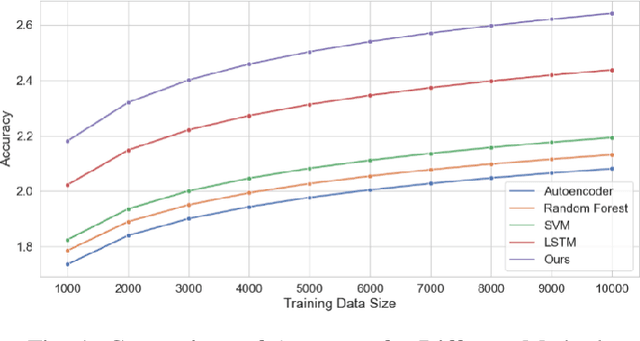
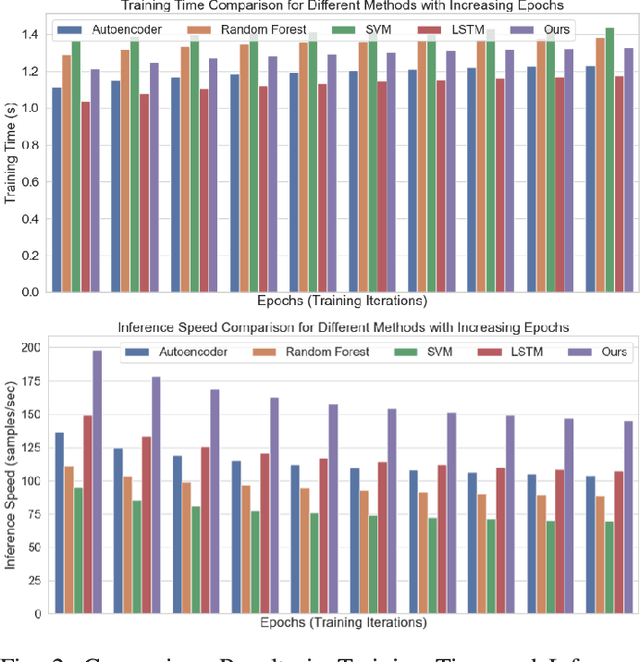
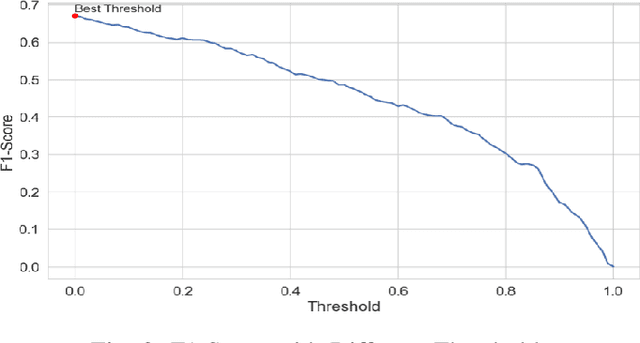

Abstract:The rapidly evolving cloud platforms and the escalating complexity of network traffic demand proper network traffic monitoring and anomaly detection to ensure network security and performance. This paper introduces a large language model (LLM)-based network traffic monitoring and anomaly detection system. In addition to existing models such as autoencoders and decision trees, we harness the power of large language models for processing sequence data from network traffic, which allows us a better capture of underlying complex patterns, as well as slight fluctuations in the dataset. We show for a given detection task, the need for a hybrid model that incorporates the attention mechanism of the transformer architecture into a supervised learning framework in order to achieve better accuracy. A pre-trained large language model analyzes and predicts the probable network traffic, and an anomaly detection layer that considers temporality and context is added. Moreover, we present a novel transfer learning-based methodology to enhance the model's effectiveness to quickly adapt to unknown network structures and adversarial conditions without requiring extensive labeled datasets. Actual results show that the designed model outperforms traditional methods in detection accuracy and computational efficiency, effectively identify various network anomalies such as zero-day attacks and traffic congestion pattern, and significantly reduce the false positive rate.
Adaptive Fault Tolerance Mechanisms of Large Language Models in Cloud Computing Environments
Mar 15, 2025Abstract:With the rapid evolution of Large Language Models (LLMs) and their large-scale experimentation in cloud-computing spaces, the challenge of guaranteeing their security and efficiency in a failure scenario has become a main issue. To ensure the reliability and availability of large-scale language models in cloud computing scenarios, such as frequent resource failures, network problems, and computational overheads, this study proposes a novel adaptive fault tolerance mechanism. It builds upon known fault-tolerant mechanisms, such as checkpointing, redundancy, and state transposition, introducing dynamic resource allocation and prediction of failure based on real-time performance metrics. The hybrid model integrates data driven deep learning-based anomaly detection technique underlining the contribution of cloud orchestration middleware for predictive prevention of system failures. Additionally, the model integrates adaptive checkpointing and recovery strategies that dynamically adapt according to load and system state to minimize the influence on the performance of the model and minimize downtime. The experimental results demonstrate that the designed model considerably enhances the fault tolerance in large-scale cloud surroundings, and decreases the system downtime by $\mathbf{30\%}$, and has a better modeling availability than the classical fault tolerance mechanism.
Research on Large Language Model Cross-Cloud Privacy Protection and Collaborative Training based on Federated Learning
Mar 15, 2025Abstract:The fast development of large language models (LLMs) and popularization of cloud computing have led to increasing concerns on privacy safeguarding and data security of cross-cloud model deployment and training as the key challenges. We present a new framework for addressing these issues along with enabling privacy preserving collaboration on training between distributed clouds based on federated learning. Our mechanism encompasses cutting-edge cryptographic primitives, dynamic model aggregation techniques, and cross-cloud data harmonization solutions to enhance security, efficiency, and scalability to the traditional federated learning paradigm. Furthermore, we proposed a hybrid aggregation scheme to mitigate the threat of Data Leakage and to optimize the aggregation of model updates, thus achieving substantial enhancement on the model effectiveness and stability. Experimental results demonstrate that the training efficiency, privacy protection, and model accuracy of the proposed model compare favorably to those of the traditional federated learning method.
Spectral Estimators for Multi-Index Models: Precise Asymptotics and Optimal Weak Recovery
Feb 03, 2025Abstract:Multi-index models provide a popular framework to investigate the learnability of functions with low-dimensional structure and, also due to their connections with neural networks, they have been object of recent intensive study. In this paper, we focus on recovering the subspace spanned by the signals via spectral estimators -- a family of methods that are routinely used in practice, often as a warm-start for iterative algorithms. Our main technical contribution is a precise asymptotic characterization of the performance of spectral methods, when sample size and input dimension grow proportionally and the dimension $p$ of the space to recover is fixed. Specifically, we locate the top-$p$ eigenvalues of the spectral matrix and establish the overlaps between the corresponding eigenvectors (which give the spectral estimators) and a basis of the signal subspace. Our analysis unveils a phase transition phenomenon in which, as the sample complexity grows, eigenvalues escape from the bulk of the spectrum and, when that happens, eigenvectors recover directions of the desired subspace. The precise characterization we put forward enables the optimization of the data preprocessing, thus allowing to identify the spectral estimator that requires the minimal sample size for weak recovery.
Style Transfer: From Stitching to Neural Networks
Sep 01, 2024Abstract:This article compares two style transfer methods in image processing: the traditional method, which synthesizes new images by stitching together small patches from existing images, and a modern machine learning-based approach that uses a segmentation network to isolate foreground objects and apply style transfer solely to the background. The traditional method excels in creating artistic abstractions but can struggle with seamlessness, whereas the machine learning method preserves the integrity of foreground elements while enhancing the background, offering improved aesthetic quality and computational efficiency. Our study indicates that machine learning-based methods are more suited for real-world applications where detail preservation in foreground elements is essential.
Quantitative Evaluation of the Saliency Map for Alzheimer's Disease Classifier with Anatomical Segmentation
Jul 11, 2024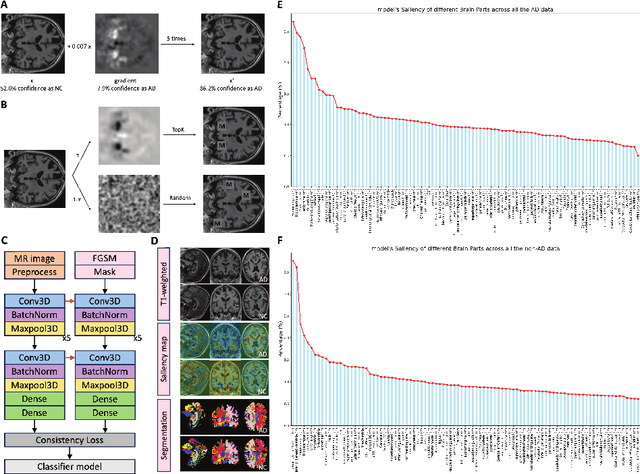

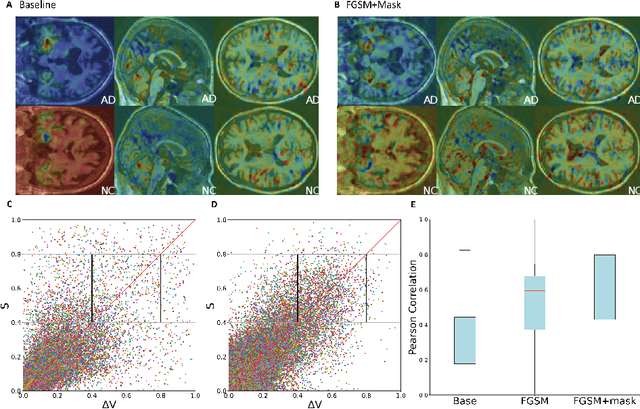
Abstract:Saliency maps have been widely used to interpret deep learning classifiers for Alzheimer's disease (AD). However, since AD is heterogeneous and has multiple subtypes, the pathological mechanism of AD remains not fully understood and may vary from patient to patient. Due to the lack of such understanding, it is difficult to comprehensively and effectively assess the saliency map of AD classifier. In this paper, we utilize the anatomical segmentation to allocate saliency values into different brain regions. By plotting the distributions of saliency maps corresponding to AD and NC (Normal Control), we can gain a comprehensive view of the model's decisions process. In order to leverage the fact that the brain volume shrinkage happens in AD patients during disease progression, we define a new evaluation metric, brain volume change score (VCS), by computing the average Pearson correlation of the brain volume changes and the saliency values of a model in different brain regions for each patient. Thus, the VCS metric can help us gain some knowledge of how saliency maps resulting from different models relate to the changes of the volumes across different regions in the whole brain. We trained candidate models on the ADNI dataset and tested on three different datasets. Our results indicate: (i) models with higher VCSs tend to demonstrate saliency maps with more details relevant to the AD pathology, (ii) using gradient-based adversarial training strategies such as FGSM and stochastic masking can improve the VCSs of the models.
Matrix Denoising with Doubly Heteroscedastic Noise: Fundamental Limits and Optimal Spectral Methods
May 22, 2024Abstract:We study the matrix denoising problem of estimating the singular vectors of a rank-$1$ signal corrupted by noise with both column and row correlations. Existing works are either unable to pinpoint the exact asymptotic estimation error or, when they do so, the resulting approaches (e.g., based on whitening or singular value shrinkage) remain vastly suboptimal. On top of this, most of the literature has focused on the special case of estimating the left singular vector of the signal when the noise only possesses row correlation (one-sided heteroscedasticity). In contrast, our work establishes the information-theoretic and algorithmic limits of matrix denoising with doubly heteroscedastic noise. We characterize the exact asymptotic minimum mean square error, and design a novel spectral estimator with rigorous optimality guarantees: under a technical condition, it attains positive correlation with the signals whenever information-theoretically possible and, for one-sided heteroscedasticity, it also achieves the Bayes-optimal error. Numerical experiments demonstrate the significant advantage of our theoretically principled method with the state of the art. The proofs draw connections with statistical physics and approximate message passing, departing drastically from standard random matrix theory techniques.
FedASTA: Federated adaptive spatial-temporal attention for traffic flow prediction
May 21, 2024



Abstract:Mobile devices and the Internet of Things (IoT) devices nowadays generate a large amount of heterogeneous spatial-temporal data. It remains a challenging problem to model the spatial-temporal dynamics under privacy concern. Federated learning (FL) has been proposed as a framework to enable model training across distributed devices without sharing original data which reduce privacy concern. Personalized federated learning (PFL) methods further address data heterogenous problem. However, these methods don't consider natural spatial relations among nodes. For the sake of modeling spatial relations, Graph Neural Netowork (GNN) based FL approach have been proposed. But dynamic spatial-temporal relations among edge nodes are not taken into account. Several approaches model spatial-temporal dynamics in a centralized environment, while less effort has been made under federated setting. To overcome these challeges, we propose a novel Federated Adaptive Spatial-Temporal Attention (FedASTA) framework to model the dynamic spatial-temporal relations. On the client node, FedASTA extracts temporal relations and trend patterns from the decomposed terms of original time series. Then, on the server node, FedASTA utilize trend patterns from clients to construct adaptive temporal-spatial aware graph which captures dynamic correlation between clients. Besides, we design a masked spatial attention module with both static graph and constructed adaptive graph to model spatial dependencies among clients. Extensive experiments on five real-world public traffic flow datasets demonstrate that our method achieves state-of-art performance in federated scenario. In addition, the experiments made in centralized setting show the effectiveness of our novel adaptive graph construction approach compared with other popular dynamic spatial-temporal aware methods.
Application of RESNET50 Convolution Neural Network for the Extraction of Optical Parameters in Scattering Media
Apr 25, 2024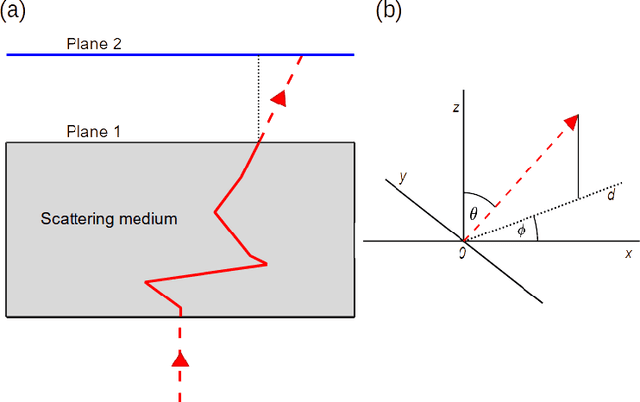


Abstract:Estimation of the optical properties of scattering media such as tissue is important in diagnostics as well as in the development of techniques to image deeper. As light penetrates the sample scattering events occur that alter the propagation direction of the photons in a random manner leading degradation of image quality. The distribution of the scattered light does, however, give a measure of the optical properties such as the reduced scattering coefficient and the absorption coefficient. Unfortunately, inverting scattering patterns to recover the optical properties is not simple, especially in the regime where the light is partially randomized. Machine learning has been proposed by several authors as a means of recovering these properties from either the back scattered or the transmitted light. In the present paper, we train a general purpose convolutional neural network RESNET 50 with simulated data based on Monte Carlo simulations. We show that compared with previous work our approach gives comparable or better reconstruction accuracy with training on a much smaller dataset. Moreover, by training on multiple parameters such as the intensity distribution at multiple planes or the exit angle and spatial distribution one achieves improved performance compared to training on a single input such as the intensity distribution captured at the sample surface. While our approach gives good parameter reconstruction, we identify factors that limit the accuracy of the recovered properties, particularly the absorption coefficient. In the light of these limitations, we suggest how the present approach may be enhanced for even better performance.
 Add to Chrome
Add to Chrome Add to Firefox
Add to Firefox Add to Edge
Add to Edge